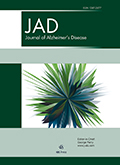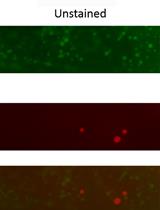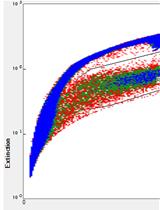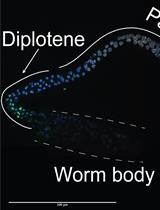- EN - English
- CN - 中文
Assessment of Chemosensory Response to Volatile Compounds in Healthy, Aged, and Neurodegenerative Caenorhabditis elegans Models
评估健康、老年和神经退行性秀丽隐杆线虫模型对挥发性化合物的化学感觉反应
发布: 2023年05月05日第13卷第9期 DOI: 10.21769/BioProtoc.4650 浏览次数: 962
评审: Juan Facundo Rodriguez AyalaDurai SellegounderRajesh RanjanAyush Ranawade
Abstract
A basic function of the nervous system is to confer the ability to detect external stimuli and generate appropriate behavioral and physiological responses. These can be modulated when parallel streams of information are provided to the nervous system and neural activity is appropriately altered. The nematode Caenorhabditis elegans utilizes a simple and well characterized neural circuit to mediate avoidance or attraction responses to stimuli, such as the volatile odorant octanol or diacetyl (DA), respectively. Aging and neurodegeneration constitute two important factors altering the ability to detect external signals and, therefore, changing behavior. Here, we present a modified protocol to assess avoidance or attraction responses to diverse stimuli in healthy individuals and Caenorhabditis elegans models associated with neurodegenerative diseases.
Keywords: Caenorhabditis elegans (秀丽隐杆线虫)Background
A basic function of the nervous system is to confer the ability to detect external stimuli and generate appropriate behavioral and physiological responses (Baidya et al., 2014). Caenorhabditis elegans has only fourteen types of chemosensory neurons but responds to dozens of chemicals, because each chemosensory neuron detects a wide variety of volatile (olfactory) and water-soluble (gustatory) cues associated with food, danger signals, or other animals (Troemel et al., 1995; Dosanjh et al., 2010). Much of its nervous system and more than 5% of its genes are devoted to the recognition of environmental chemicals. Chemosensory cues can elicit chemotaxis, rapid avoidance, changes in overall motility, and entry into or exit from the alternative dauer developmental stage. These behaviors are regulated by eleven pairs of chemosensory neurons. Each amphid sensory neuron expresses a specific set of candidate receptor genes and detects a characteristic set of attractants, repellents, or pheromones (Bargmann, 2006). Olfaction is a versatile and sensitive mechanism for detecting volatile odorants. Many of these responses are mediated (at least in part) by a pair of ciliated sensory neurons named ASH, which have sensory openings at the anterior amphid pore at the nose of the animal and are thought to be analogous to polymodal nociceptive neurons in vertebrates; other sensory neurons (e.g., ADL, AWB, ASK) are thought to play minor and auxiliary roles in avoidance responses (Figure 1). The avoidance response to 30% octanol via ASH neurons is enhanced by serotonin; furthermore, altering serotonin levels results in ADL and AWB neurons being recruited to detect 100% octanol redundantly with ASH neurons (Chao et al., 2004). In the nematode, the presence of this compound has a strong modulatory influence on many behaviors. For instance, the olfaction of octanol or diacetyl (DA) stimulates C. elegans mechanosensory neurons to release dopamine, which affects many behaviors including locomotion rate (Sawin et al., 2000), foraging, and response to soluble repellants (Ezcurra et al., 2011). In this protocol, we describe how to evaluate the time response against attractants and repellents in the nematode C. elegans to study the neuronal system and behavioral response of worms, and how this can be translated to neuronal diseases in worms fed on different bacteria. For example, as worms age, they have more difficulty sensing octanol and their avoidance response slows, the same being observed with the DA (Figure 1). This protocol has the advantage of not requiring a centrifugation step, which could severely damage aged and sick worms. As far as we know, this protocol is the first one to be applied to assess neurological damage in C. elegans.
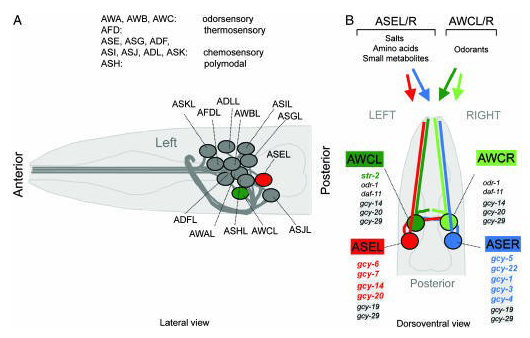
Figure 1. Introduction to C. elegans sensory anatomy. (A) A prominent and well-characterized subset of C. elegans sensory neurons, the amphid sensory neurons. As with most other neuron classes, amphid sensory neuron classes consist of one pair of bilaterally symmetric cells (see also B). Each of the 12 pairs of amphid sensory neurons extends a dendrite to the tip of the nose and an axon into the nerve ring, a nerve bundle where synaptic connections are made (White et al., 1986). Delineated functions of amphid sensory neurons are indicated (Bargmann and Mori 1997). (B) Amphid sensory neuron classes consist of two bilaterally symmetric pairs of neurons, two of which, AWCL/R and ASEL/R, are functionally lateralized. While some other amphid sensory neurons appear to contribute to gustation, ASE is the main gustatory neuron class in C. elegans, mediating responses to salts, amino acids, and small metabolites (Bargmann et al., 1993). ASE mediates not only attractive but also repulsive responses to specific chemicals (Sambongi et al., 1999). The salts sodium, chloride, and potassium are sensed in a left/right asymmetric manner, with ASEL sensing sodium but not chloride and potassium, and ASER sensing chloride and potassium (Pierce-Shimomura et al., 2001). It is not yet known whether other ASE-sensed chemicals may also activate ASEL and ASER differentially. ASE-expressed GCY genes are shown and those that are asymmetric are colored. The AWCL/R neurons can discriminate benzaldehyde and butanone on the basis of the left/right asymmetric expression of str-2 (colored), a G-protein coupled receptor, which is stochastically expressed in either AWCL or AWCR (Troemel et al., 1999; Wes and Bargmann, 2001). Newly identified GCY genes in AWC are shaded. Figure taken from Ortiz et al. (2006).
Materials and Reagents
Glass media bottles 200 mL (Fisher Scientific, catalog number: FB800250).
Petri dishes 60 × 15 mm 500/cs (Fisher Scientific, catalog number: FB0875713A)
Pipette tips 2–200 µL Eppendorf® epT.I.P.S. (Eppendorf, catalog number: 022492039)
Pipette tips 50–1,000 µL Eppendorf® epT.I.P.S. (Eppendorf, catalog number: 022492055)
Eppendorf® Safe-Lock 1.5 mL microcentrifuge tubes (Eppendorf, catalog number: 022363204)
Corning® 15 mL centrifuge tubes (Corning, catalog number: 430791)
C. elegans strains were obtained from Caenorhabditis Genetics Center: N2 Bristol (WormBase ID: WBStrain00000001; dvIs15), CL2122 (WBStrain00005101), and CL2355 [WBStrain00005106; smg-1(cc546); pCL45 [Psnb-1::human Amyloid beta 1-42::3' UTR (long); Pmtl-2::GFP]]
Escherichia coli strain OP50 (University of Minnesota, C. elegans Genetics Center, MN)
Bacillus subtilis strain NCIB3610 (Bacillus Genetic Stock Center, catalog numbers: 3A1 and 1A96)
Magnesium sulfate heptahydrate (MgSO4·7H2O) (Sigma-Aldrich, catalog number: M1880)
Potassium phosphate monobasic (KH2PO4) (Sigma-Aldrich, catalog number: P5655)
Potassium phosphate dibasic (K2HPO4) (Sigma-Aldrich, catalog number: P2222)
Sodium phosphate dibasic heptahydrate (Na2HPO4·7H2O) (Sigma-Aldrich, catalog number: 7782-85-6)
Sodium chloride (NaCl) (Sigma-Aldrich, catalog number: S7653)
NaClO hypochlorite (Sigma-Aldrich, catalog number: 13440)
Sodium hydroxide (NaOH) (Sigma-Aldrich, catalog number: S8045)
Bacto peptone (BD, BactoTM, catalog number: 211677)
Agar (Sigma-Aldrich, catalog number: A1296)
Cholesterol (Sigma-Aldrich, catalog number: C8667)
100% ethanol (Sigma-Aldrich, catalog number: E7023)
Calcium chloride dihydrate (CaCl2·2H2O) (Sigma-Aldrich, catalog number: C3881)
Luria broth (LB) (Sigma-Aldrich, catalog number: L3522)
Octanol (1-octanol) (Sigma-Aldrich, catalog number: 472328)
Diacetyl (DA) (butane-2,3-dione) (Sigma-Aldrich, catalog number: B85307)
M9 buffer (see Recipes)
Nematode growth medium (NGM) agar (see Recipes)
Potassium phosphate buffer (see Recipes)
1 M MgSO4·7H2O (see Recipes)
Cholesterol in absolute ethanol (5 mg/mL) (see Recipes)
1 M CaCl2 (see Recipes)
Potassium phosphate buffer (1 M KPO4, pH 6.0) (see Recipes)
LB media (see Recipes)
Bleaching solution (see Recipes)
1 N NaOH (see Recipes)
0.5% DA (see Recipes)
S-basal buffer (see Recipes)
Equipment
Shaker (Axyos Technologies, catalog number: S04036.tu)
Dissecting microscope (Carl Zeiss, catalog number: 3944010970)
Commercially available paintbrush number: 10/0; 0.2 × 0.2 × 6.5 inches (Princeton art & Brush, catalog number: B0043GCYSI).
Autoclave (Tuttnauer USA, model: 6690)
Worm pick. Worm picks can either be purchased (Genesee Scientific, catalog number: 59-AWP) or made in the lab as described in Wollenberg et al. (2013).
Centrifuge (Eppendorf, model: 5430)
Tabletop centrifuge (Eppendorf, model: 5424)
Bunsen burner (Humbolt, catalog number: H-5870)
Chronometer (Hinotek, catalog number: PS-360A)
Software
Microsoft Excel (Microsoft Corporation, Redmond, USA)
GraphPad Prism 8 (GraphPad Software, Inc.)
Procedure
文章信息
版权信息
© 2023 The Author(s); This is an open access article under the CC BY-NC license (https://creativecommons.org/licenses/by-nc/4.0/).
如何引用
Crespo, C. and Grau, R. (2023). Assessment of Chemosensory Response to Volatile Compounds in Healthy, Aged, and Neurodegenerative Caenorhabditis elegans Models. Bio-protocol 13(9): e4650. DOI: 10.21769/BioProtoc.4650.
分类
神经科学 > 神经系统疾病 > 动物模型
发育生物学 > 细胞信号传导 > 胁迫反应
细胞生物学 > 细胞信号传导 > 胁迫反应
您对这篇实验方法有问题吗?
在此处发布您的问题,我们将邀请本文作者来回答。同时,我们会将您的问题发布到Bio-protocol Exchange,以便寻求社区成员的帮助。
提问指南
+ 问题描述
写下详细的问题描述,包括所有有助于他人回答您问题的信息(例如实验过程、条件和相关图像等)。
Share
Bluesky
X
Copy link



